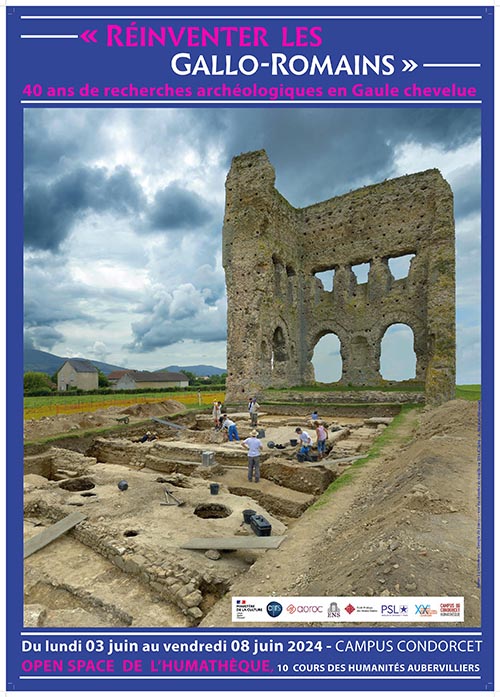
Visits and exhibitionsExhibition at Campus Condorcet 'Reinventing the Gallo-Romans' 40 years of archaeological research in Gallia Colmata Humathèque, June 3-9, 2024
_____________________________________________________________________________________________________
Following the exhbition "Reinventing the Celts" and its catalogue, AOROC, CNRS Archaeological Research Institute at ENS, EPHE and PSL University, the University Lumière Lyon 2 and Archaeological Institute and Museum of Bibracte (EPCC) wanted to organise an exhibition iwith the same scope and ambition, "Reinventing the Gallo-Romans" The aim is to consider the impact of the Roman conquest on Gaul in the light of the realities in the field, highlighting the contribution made by the Gauls to the development of the provinces. Gallia Colmata, which was less Romanised, particularly in the countryside, shows the confrontation of two worlds, one Celtic, the other Mediterranean, which mutually enriched each other. Far from claiming to be exhaustive, the objective here is to offer a series of snapshots based on key studies from archaeological scientific investigation and mitigation from Britanny to the Switzerland, from Paris to the Rhône valley or Aquitaine. Thanks to the contributions of more than sixty archaeologists, the book will look in turn at the markers of Romanity, the legacy of the Iron Age, the characteristics of urban and rural areas, the driving forces behind the economy, changes in dietary habits and religious and funerary practices. Après l’exposition « Réinventer les Celtes » et son catalogue, les équipes des laboratoires AOROC – Paris PSL, de l’université Lumière Lyon 2 et de l’EPCC Bibracte ont souhaité organiser dans le même esprit l’exposition « Réinventer les Gallo-Romains ». Sponsors : Ministère de la Culture, Laboratoire AOROC, UMR 8546 CNRS-ENS-EPHE-PSL, XXe Congrès International d’Archéologie Classique. Logistics : Campus Condorcet, Humathèque, service communication de l’EPHE-PSL. Organizers : Katherine Gruel, Laure Laüt, Matthieu Poux, François Ory. Scientific committee : Philippe Barral, Cristina Gandini, Martine Joly, Pierre Nouvel. Conception and design : François Ory.
____________________________________________________________________________________________________ Plenum Archaeological research in the feminine: figures, careers and issues Humathèque, 6 juin 2024
_____________________________________________________________________________________________________
Musée du Louvre
Our partner, the Musée du Louvre, is offering to organise a private tour of some of its collections for participants in the CIAC Paris 2024 conference on Tuesday 4 June 2024, who have registered in advance on this website. The Museum can only offer this visit to the first 95 people to register. Professors (whatever their rank), curators and students under the age of 26 will be free to visit the rest of the week, after obtaining a free ticket from the Louvre website (https://www.ticketlouvre.fr/louvre/b2c/index.cfm/home ). Proof of professional or academic status will be required at the entrance. ___________________________________________________________________________________________________
Musée d'Archéologie Nationale Saint-Germain-en-Laye Our partner, the Musée d'Archéologie Nationale, will be welcoming all participants with their CIAC badges to Saint-Germain-en-Laye. This is the second most important archaeological museum after the Louvre. It will be closed on Tuesday 4 June, but open for you the rest of the week (from 10 am to 6 pm). You will be able to see its exceptional prehistoric and protohistoric collections, as well as its exhibition on the Gallo-Roman city of Autun, one of the cradles of Roman culture, famous for its school of rhetoric, and its exhibition on the astrological tablets from Grand (Vosges), which date back to Late Antiquity and the two panels are being brought together for the first time. The AOROC laboratory produced the 3D model, which you can view by clicking here. To go to the museum, please follow this link... The direction of the museum does not require you to register in advance. |


